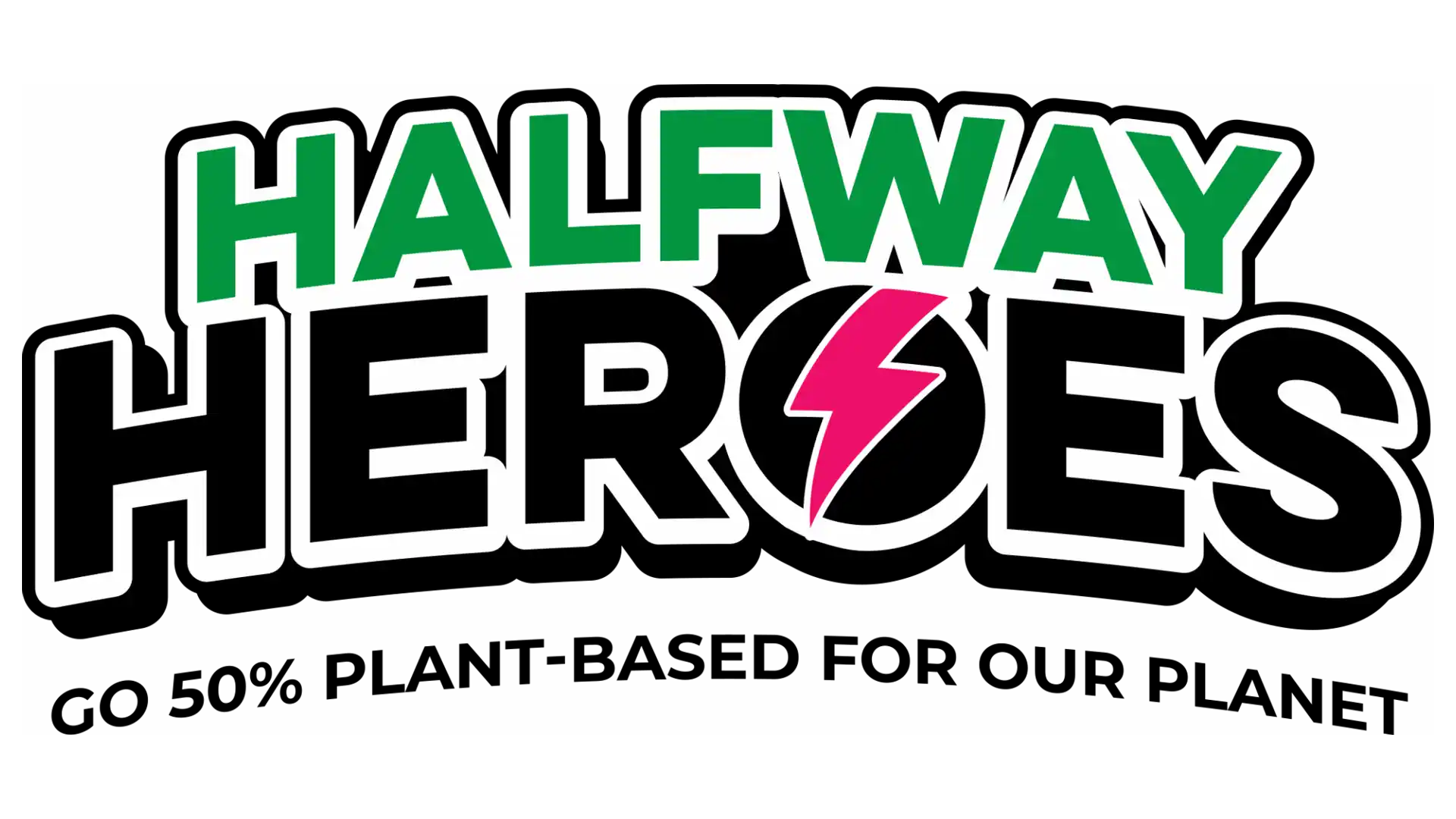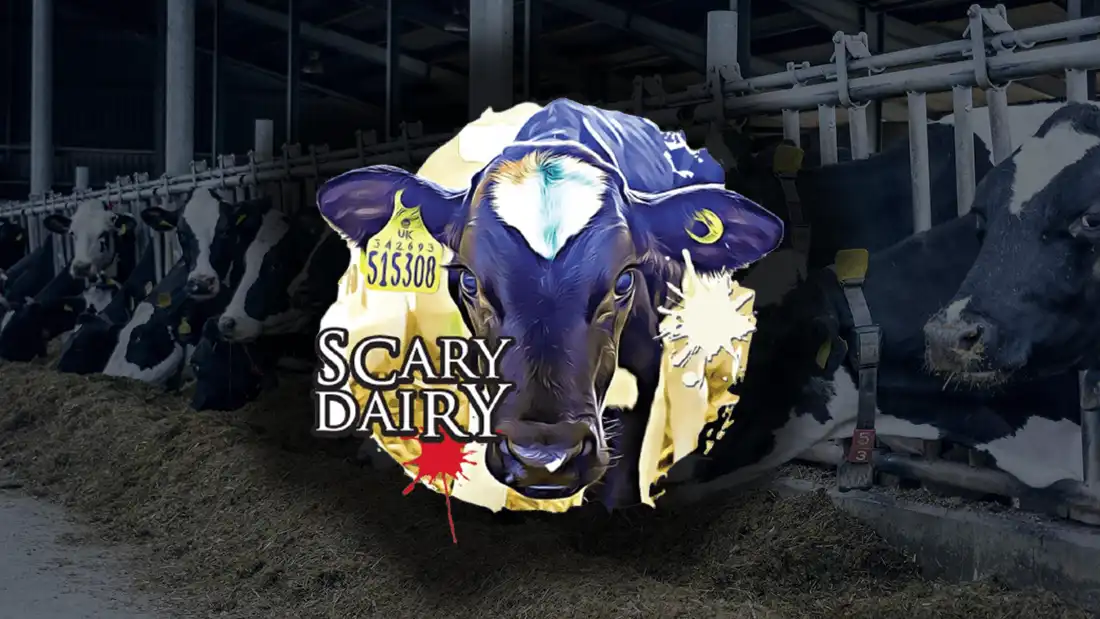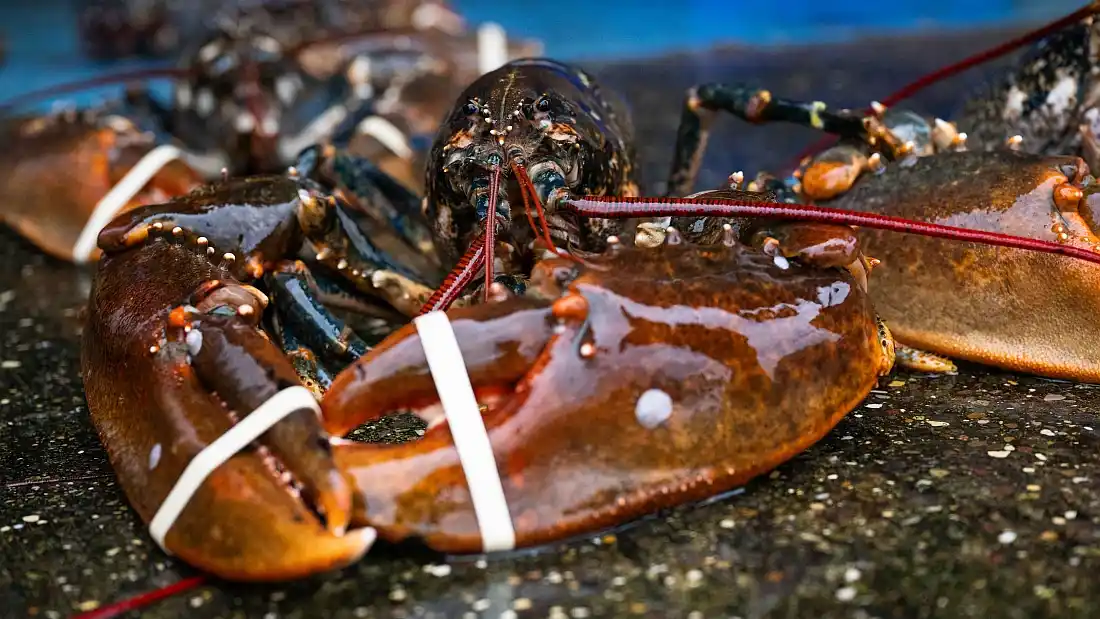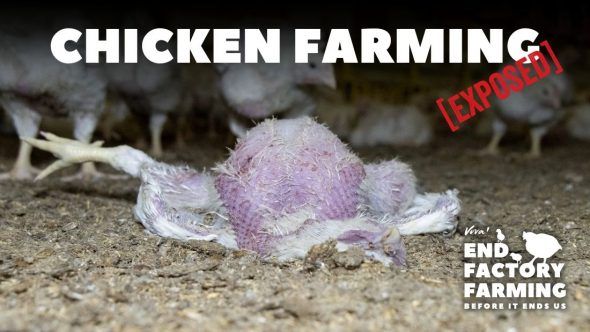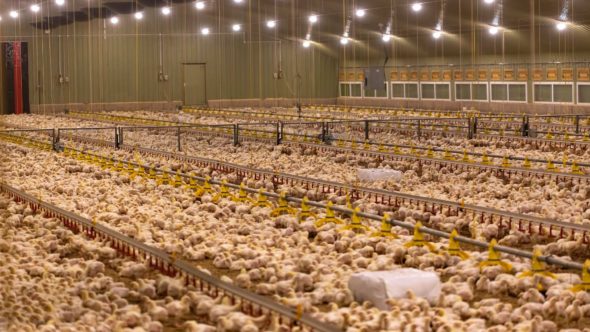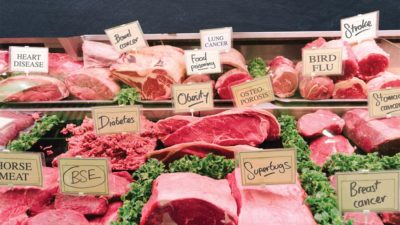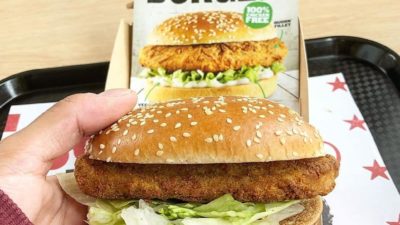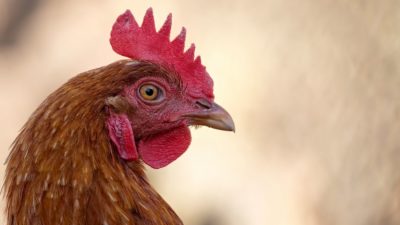How Broiler Chickens Are Farmed and Killed

- Chickens are the closest living relative of the dinosaur T. rex1Asara JM, Schweitzer MH, Freimark LM et al. 2007. Protein sequences from mastodon and Tyrannosaurus rex revealed by mass spectrometry. Science. 316 (5822) 280-285.
- Chickens use over 24 different vocalisations to raise alarms, for example, or let others know when they find food2Smith CK and Zielinski SL. 2014. Brainy bird. Scientific American. 310 (2) 60-65.3Marino L. 2017. Thinking chickens: a review of cognition, emotion, and behavior in the domestic chicken. Animal Cognition. (2) 127-147.
- Chicks and mothers talk before hatching4Edgar J, Held S, Jones C et al. 2016. Influences of maternal care on chicken welfare. Animals (Basel). 6 (1) 2.
- ‘Peeping’ or clicking from the egg helps synchronise the hatching of chicks.5Tong Q, Romanini CE, Exadaktylos et al. 2013. Embryonic development and the physiological factors that coordinate hatching in domestic chickens. Poultry Science. 92 (3) 620-628.
- Chickens recognise faces of individuals from within and outside their group and can even recognise others shown in colour slides3Marino L. 2017. Thinking chickens: a review of cognition, emotion, and behavior in the domestic chicken. Animal Cognition. (2) 127-147.
- Chickens feel empathy – an ability usually associated with dogs, wolves, great apes or pigs3Marino L. 2017. Thinking chickens: a review of cognition, emotion, and behavior in the domestic chicken. Animal Cognition. (2) 127-147.
- Chickens have tetrachromatic vision and can see red, blue and green light, as well as ultraviolet light6Seifert M, Baden T and Osorio D. 2020. The retinal basis of vision in chicken. Seminars in Cell and Developmental Biology. 106, 106-115.
- Chickens can focus close-up and far away at the same time3Marino L. 2017. Thinking chickens: a review of cognition, emotion, and behavior in the domestic chicken. Animal Cognition. (2) 127-147.
- Chickens can count up to five from birth, display self-control, are capable of social learning, have episodic memories and are able to deceive others to benefit themselves – a sign of Machiavellian intelligence8Marino L. 2017. Thinking chickens: a review of cognition, emotion, and behavior in the domestic chicken. Animal Cognition. (2) 127-147.
- Chickens are as clever as some mammals; their intelligence rivals that of dogs, primates and in some tasks, human toddlers!3Marino L. 2017. Thinking chickens: a review of cognition, emotion, and behavior in the domestic chicken. Animal Cognition. (2) 127-147.
- One of the most ubiquitous domesticated animals; there are more than three chickens for every person on the planet at any one time!7Statista.com. 2020. Number of chickens worldwide from 1990 to 2018. Available at:https://www.statista.com/statistics/263962/number-of-chickens-worldwide-since-1990/
Whether they are warning others of danger, showing off or reassuring their young, chickens are quite the chatterboxes.
Both male and female chickens can communicate with over 24 vocalisations, each with a distinct meaning. What may just sound like random clucking to us is actually a variety of complex, unique signals communicating a range of meanings from ‘I’m hungry’, to ‘Watch out, there’s danger!’1Marino L. 2017. Thinking chickens: a review of cognition, emotion, and behavior in the domestic chicken. Animal Cognition. (2) 127-147.
From the embryo
Communication between a hen and her chicks starts before they’re even hatched. While still in the egg, a developing chick may emit a distress call if he or she is too cold, prompting the mother hen to move onto the nest. Following this, the chick may become silent or emit a pleasure call.2Edgar J, Held S, Jones C et al. 2016. Influences of maternal care on chicken welfare. Animals (Basel). 6 (1) 2. As the chick forms inside the egg, they are able to hear their mother’s calls and respond. These vocalisations help birds recognise their mother after hatching.2Edgar J, Held S, Jones C et al. 2016. Influences of maternal care on chicken welfare. Animals (Basel). 6 (1) 2.
This communication isn’t just limited to hens and their offspring, chicks also communicate with each other in the nest. Synchronous hatching is when the eggs hatch within hours of each other even though they have been laid days apart. It offers several advantages and increases the chances of survival. Maternal calls and chicks ‘clicking’ during late development help synchronise hatching.3Tong Q, Romanini CE, Exadaktylos et al. 2013. Embryonic development and the physiological factors that coordinate hatching in domestic chickens. Poultry Science. 92 (3) 620-628.
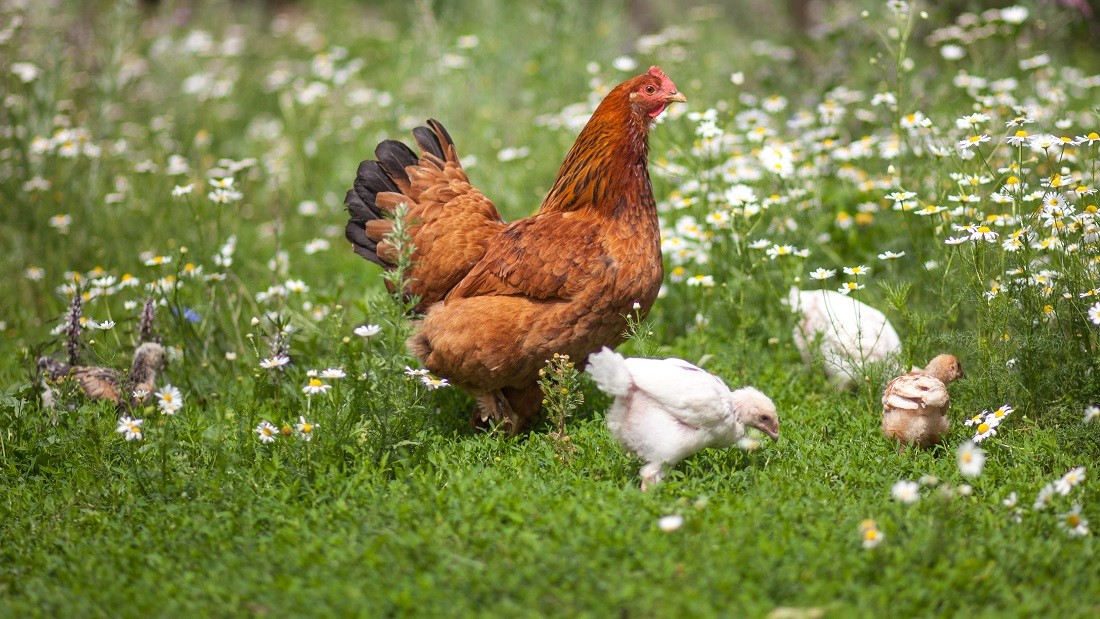
Complex signals
Chickens use referential calls, meaning that they refer to specific objects and events. This type of functionally referential communication is associated with animals of high intelligence such as dolphins, primates, domestic dogs, pigs and some birds, such as ravens.1Marino L. 2017. Thinking chickens: a review of cognition, emotion, and behavior in the domestic chicken. Animal Cognition. (2) 127-147.Whilst all we may hear is a cacophony of clucking, when chickens talk they actually use a whole range of different signals for different purposes, such as calls, displays and whistles. They can even use them to confuse or deceive other birds.1Marino L. 2017. Thinking chickens: a review of cognition, emotion, and behavior in the domestic chicken. Animal Cognition. (2) 127-147.
The type of alarm call used varies according to the threat; different calls are used for aerial and ground predators. The strongest alarm calls are made when large, fast-moving hawks fly overhead. Accordingly, the response of other birds shows that they recognise the meaning of these different calls.1Marino L. 2017. Thinking chickens: a review of cognition, emotion, and behavior in the domestic chicken. Animal Cognition. (2) 127-147.
What type of call a chicken uses is not only dependent on their understanding of the situation they are in; it includes social awareness. Roosters who see a threat overhead, for instance, are more likely to make an alarm call if they know a female is nearby but might remain silent in the presence of a rival male. Females are equally selective, only sounding an alarm when they have chicks.4Smith CK and Zielinski SL. 2014. Brainy bird. Scientific American. 310 (2) 60-65.
Unique voices
Chickens have their own distinctive voices. Every rooster’s crow call is unique and correlates with his comb length (the feathered crest on the top of his head) – an indicator of male dominance.5Favati A, Løvlie H and Leimar O. 2021. Effects of social experience, aggressiveness and comb size on contest success in male domestic fowl. Royal Society Open Science. 8 (2) 201213.Roosters also listen to other roosters to assess each other’s status within the social hierarchy. The highest-ranking bird is usually the first to crow at dawn, followed by their subordinates, in descending order of social rank.6Shimmura T, Ohashi S and Yoshimura T. 2015. The highest-ranking rooster has priority to announce the break of dawn. Scientific Reports. 5, 11683.
As the rooster’s call is distinctive, he broadcasts his identity to the whole group. When he finds food, he combines his call with rhythmic movements involving picking up and dropping the food morsel repeatedly – a signal called the tidbitting display. Hens assess this display to help them decide which males will provide food and, thus, with whom they want to mate.1Marino L. 2017. Thinking chickens: a review of cognition, emotion, and behavior in the domestic chicken. Animal Cognition. (2) 127-147.However, some males make this call when there is no food, to lure female chickens closer so they can defend her from other males. Of course, females develop counterstrategies and stop responding to males who call too often in the absence of food.1Marino L. 2017. Thinking chickens: a review of cognition, emotion, and behavior in the domestic chicken. Animal Cognition. (2) 127-147.
Their selectivity, about how and when to use certain calls, suggests that chicken communication is shaped by social awareness and the ability to think before they act. Years of research have only just begun to show how complex chicken communication is but what is clear is that their communication skills provide evidence of similarity with other highly intelligent complex social species, including primates.
Brainy birds
Chickens have distinct personalities, just like all animals who are cognitively, emotionally and behaviourally complex individuals.1Marino L. 2017. Thinking chickens: a review of cognition, emotion, and behavior in the domestic chicken. Animal Cognition. (2) 127-147.They can demonstrate self-assessment, self-control and psychological complexity by flexibly and often strategically, navigating a dynamic network of social relationships.1Marino L. 2017. Thinking chickens: a review of cognition, emotion, and behavior in the domestic chicken. Animal Cognition. (2) 127-147.In other words, just like many animals, including humans, their behaviour varies according to who else is around!
They show emotional contagion (transferring feelings to others around them) as well as empathy and are capable of a form of deductive reasoning called transitive inference – which allows them to derive a relation between items that have not been compared before. This capability develops in humans around the age of seven.1Marino L. 2017. Thinking chickens: a review of cognition, emotion, and behavior in the domestic chicken. Animal Cognition. (2) 127-147.They also have an understanding of numbers and possess some basic arithmetic capacities from birth.
There is no dividing line between avian and mammalian intelligence and complexity; complex intelligence is found in birds, mammals and fish.1Marino L. 2017. Thinking chickens: a review of cognition, emotion, and behavior in the domestic chicken. Animal Cognition. (2) 127-147.Unfortunately, most people regard chickens simply as food or a commodity and therefore see them as lacking most of the characteristics used to describe other cognitively advanced animals.
There is no question that chickens are intelligent animals, capable of understanding the world around them. This raises important questions about how they are bred for food and kept in factory farms.
Where do chickens descend from?
The domestic chicken (Gallus gallus domesticus) is thought to have been domesticated from the wild red junglefowl (Gallus gallus) of Southeast Asia and parts of South Asia1Hata A, Nunome M, Suwanasopee T et al. 2021. Origin and evolutionary history of domestic chickens inferred from a large population study of Thai red junglefowl and indigenous chickens. Scientific Reports. 11, 2035., with other junglefowl species possibly adding to the genetic mix over time.2Lawal RA, Martin SH and Vanmechelen K et al. 2020. The wild species genome ancestry of domestic chickens. BMC Biology. 18, 13.
The male red junglefowl is a magnificent bird with a plumage of gold, red, brown, dark maroon and orange, with flecks of metallic green and grey. They have impressive tail feathers, which can be up to 28 centimetres long. You can still see wild red junglefowl today, where chickens originated, in the forests of Southeast Asia, and parts of South Asia.
Junglefowl are active early in the morning, sleep during the day and wake again from late afternoon until dusk. Much of their day is spent foraging for insects, small snakes or lizards, and scratching at the ground looking for seeds and berries.3KC Klasing. 2005. Poultry nutrition: a comparative approach. Journal of Applied Poultry Research. 14, 2, 426-436.
The history of chickens
Domestication of chickens began around 3,500 years ago4Peters J, Lebrasseur O, Irving-Pease EK et al. 2022. The biocultural origins and dispersal of domestic chickens. Proceedings of the National Academy of Sciences USA. 119 (24) e2121978119., not 8,000 or even 10,000 as previously suggested.5Sawai H, Kim HL, Kuno K et al. 2010. The origin and genetic variation of domestic chickens with special reference to junglefowls Gallus g. gallus and G. varius. PLoS One. 5 (5) e10639.Confusion may have arisen because chicken bones are easily mistaken for those of other birds, such as pheasants. Wild pheasants are thought to have lived alongside humans in China well before chickens were introduced.6Barton L, Bingham B, Sankaranarayanan K et al. 2020. The earliest farmers of northwest China exploited grain-fed pheasants not chickens. Scientific Reports. 10, 2556.
Also, some chicken bones found deep in the earth were placed there by burrowing animals. Radiocarbon dating of one bone from a site in Bulgaria estimated to be 7,500 years old, turned out to belong to a chicken that likely lived between 1959 and 1985.7Best J, Doherty S, Armit I et al. 2022. Redefining the timing and circumstances of the chicken’s introduction to Europe and north-west Africa. Antiquity. 96 (388) 868-882.
Recent studies reassessing the evidence now suggest that domestication dates back to around 1650 to 1250 BCE (about 3,500 years ago) in Southeast Asia, coinciding with dry rice and millet cultivation that likely attracted red junglefowl into human settlements.4Peters J, Lebrasseur O, Irving-Pease EK et al. 2022. The biocultural origins and dispersal of domestic chickens. Proceedings of the National Academy of Sciences USA. 119 (24) e2121978119.It’s thought they followed a typical domestication pattern with the tamest animals thriving, thus starting a genetic drift from their wild ancestors and spreading into Central Asia by 2,500 years ago. They continued west, moving on to grains such as wheat and barley. By the sixth to fifth centuries BCE, chickens had made it into central Europe and Britain; becoming incorporated into human culture and forming a close relationship with humans.7Best J, Doherty S, Armit I et al. 2022. Redefining the timing and circumstances of the chicken’s introduction to Europe and north-west Africa. Antiquity. 96 (388) 868-882.
Too good to eat!
Far from being regarded as an edible commodity, early chickens were revered, maybe even loved. Early evidence of a close relationship between chickens and humans comes from whole chicken skeletons found alongside Bronze Age human burials in Thailand (800 BCE), China (1320 to 1046 BCE) and Italy (1000 to 800 BCE).7Best J, Doherty S, Armit I et al. 2022. Redefining the timing and circumstances of the chicken’s introduction to Europe and north-west Africa. Antiquity. 96 (388) 868-882.Similar early skeletons have been found in many places, often older animals showing no signs of butchery or human consumption. In Hampshire, England, the long spurs on a cockerel found at Houghton Down suggest he was over two years old and at Weston Down, a mature hen with a well-healed leg fracture suggests evidence of human care.7Best J, Doherty S, Armit I et al. 2022. Redefining the timing and circumstances of the chicken’s introduction to Europe and north-west Africa. Antiquity. 96 (388) 868-882.
Rather than being considered as food, these early arrivals to northern Europe were more likely regarded as exotic creatures that possessed supernatural status. By being buried in human graves, maybe there was hope that they would lead human souls to the afterlife.7Best J, Doherty S, Armit I et al. 2022. Redefining the timing and circumstances of the chicken’s introduction to Europe and north-west Africa. Antiquity. 96 (388) 868-882.
Across Britain, chickens were not regularly consumed until the third century AD and then, mainly on Romanised urban and military sites.7Best J, Doherty S, Armit I et al. 2022. Redefining the timing and circumstances of the chicken’s introduction to Europe and north-west Africa. Antiquity. 96 (388) 868-882.Evidence suggests that, in Britain, it took 700 to 800 years from their initial introduction as exotic animals, who were not for eating, to their acceptance as food.7Best J, Doherty S, Armit I et al. 2022. Redefining the timing and circumstances of the chicken’s introduction to Europe and north-west Africa. Antiquity. 96 (388) 868-882.
According to Dr Greger Larson, Professor of Archaeology at Oxford University, it’s only really since World War Two that we started regarding chickens with disrespect; making them the butt of jokes like “chicken-shit”. He says: “We denigrate them to make it easier to eat them. Before that, they were venerated. Look at any church steeple and you are going to find a chicken on top. You are not going to put something you hate or think is stupid on the top of a church.”8Newby J. 2023. The true story of the chicken. Cosmos. Available at https://cosmosmagazine.com/history/history-of-chickens/ [Accessed 12 December 2023].
Today, of the 70 or so billion chickens on the planet, most are commercially reared indoors at high stocking densities for meat, bred for rapid muscular growth during their short lives. The average age at slaughter in Europe is just 28 to 42 days old.9EFSA AHAW Panel (EFSA Panel on Animal Health and Animal Welfare), Nielsen SS, Alvarez J, Bicout DJ et al. 2023. Welfare of broilers on farm. EFSA Journal. 21 (2) e7788. They are no longer buried as individuals, with people or on their own, and instead are often discarded as fast-food litter in the street.
Different breeds
Hundreds of breeds of chicken exist around the world today.15Xu J, Fu Y, Hu Y et al. 2020. Whole genome variants across 57 pig breeds enable comprehensive identification of genetic signatures that underlie breed features. Journal of Animal Science and Biotechnology. 11 (1) 115.The British Poultry Standards recognise over 100 varieties, classified by size, feathering, origin and rarity.11The Poultry Club of Great Britain. 2018. British Poultry Standards, 7th Edition. Eds. J Ian H Allonby and Philippe B Wilson. Wiley-Blackwell.Popular ‘backyard’ breeds include the Rhode Island Red, Leghorn, Ameraucana, Wyandotte, Australorp, Buff Oprington, Sussex and Plymouth Rock. However, of the many different breeds that exist, only a few are kept on factory farms, but in their billions. The most commonly farmed breeds of chicken for meat (broiler chickens) include Ross, Hubbard and Cobb hybrids, while egg-laying hens can be Golden Comet, Leghorn, Australorp and Rhode Island Red cross-breeds, all prized for their ‘high productivity’ in egg laying.
Despite their long history of domestication, recent intense breeding and genetic selection, domestic chickens maintain many of the same traits as their wild ancestors. In other words, they inherited their smartness from wild red junglefowl. Most animals domesticated for food, such as pigs and chickens, are behaviourally and cognitively similar to their ancestors and wild counterparts as selection is largely based on physical attributes like growth rate, fertility and levels of body fat.12Marino L. 2017. Thinking chickens: a review of cognition, emotion, and behavior in the domestic chicken. Animal Cognition. (2) 127-147.
The advanced mental capacities that you see in domesticated chickens today are a result of adapted responses to threats from predators, such as foxes and birds of prey, coupled with their need for strategies to deal with the pressure of competition in the pecking order.13Smith CL and Zielinski SL. 2014. The startling intelligence of the common chicken. Scientific American.
Red junglefowl have a hierarchical social system in which there is a ‘pecking order’ for both males and females. In the spring, at the onset of the breeding season, each of the stronger males maintains a territory with three to five hens. Meanwhile, young males live isolated in twos and threes.14The South Asia Pro-Poor Livestock Policy Programme. 2014. Red jungle fowl. Available at: http://www.sapplpp.org/interactive-maps/indigenous-poultry-breeds-of-india/red-junglefowl.html [Accessed 28 November 2023].Roosters spend much of their time strutting their stuff, trying to impress females and provide them with food. Hens diligently watch on, judging males on their behaviour and their ability to protect and provide food. They remember past events, shunning nasty or deceptive males.13Smith CL and Zielinski SL. 2014. The startling intelligence of the common chicken. Scientific American.
The unrelenting threat from predators also dictates the junglefowl’s behaviour – they have had to evolve different strategies for different threats; as well as ways to warn other chickens about the dangers. They also choose carefully who to tell! If you live with chickens, you’ll know how roosters are always watching over the hens and a vigilant rooster may appear to never rest. He’ll scan the sky and landscape for potential predators, warning the hens when he senses danger.
An understanding of the behavioural and cognitive sophistication of chickens should, according to scientists, encourage a more positive and respectful opinion of them.
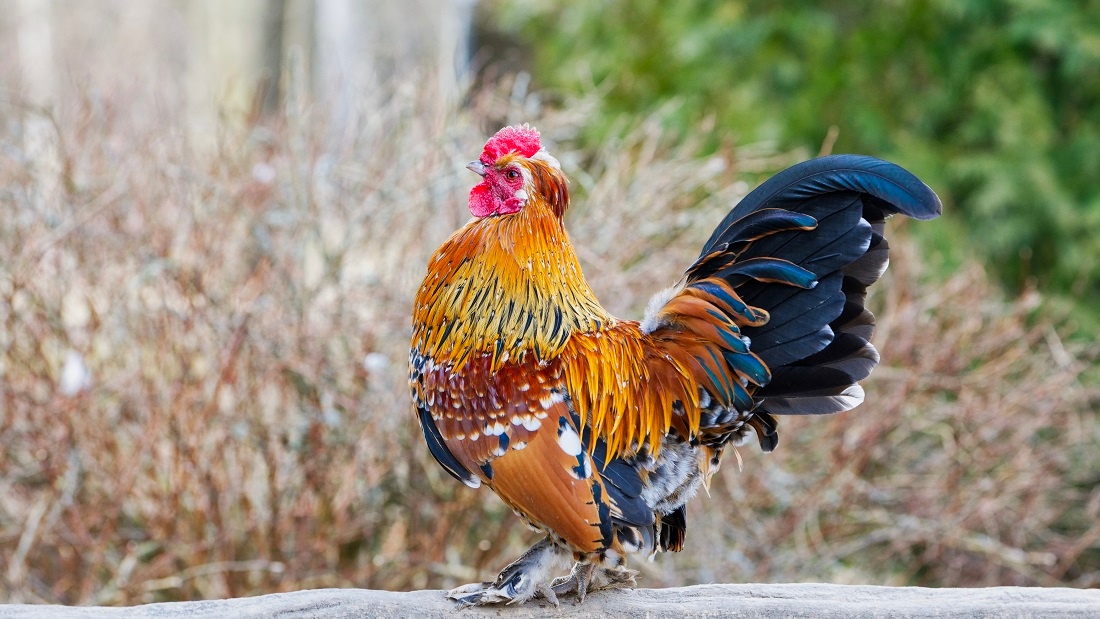
A natural hierarchy
Chickens are naturally social birds who, in the wild, live together long-term as a flock in groups of four to 13 individuals of varying ages. A flock will always have a distinct hierarchy or pecking order, giving dominant individuals priority over food access and nesting locations.13Smith CL and Zielinski SL. 2014. The startling intelligence of the common chicken. Scientific American.
Chicks start to form social hierarchies from around five to six weeks of age, when they naturally become independent from their mother. The purpose of the pecking order is to establish the social standing of each bird within the flock, keep order and reduce conflict. Differences such as body weight and comb size play a major part in determining where chickens fit in the pecking order alongside behavioural factors such as being more willing to explore or being more vigilant after a startle.15Garnham L and Løvlie H. 2018. Sophisticated fowl: the complex behaviour and cognitive skills of chickens and red junglefowl. Behavioural Sciences (Basel). 8 (1) 13.
Behaviours such as flaring feathers and bumping chests will be used to establish order amongst young chickens. Throughout their lives, social order dynamics will take place rooster to rooster, hen to hen and rooster to hen. For a rooster to move up the social standing, he has to win a battle against the lead rooster to. Defeated roosters go down the ladder, as do weak or sickly birds.
Hens have their own social ladder, headed up by the matriarchs of the flock – generally the older and stronger hens. Higher-ranked hens will display warning behaviours such as pecks and feather pulling or even jumping on another hen or clawing them to let the lower-ranked hen know she has overstepped her boundary. Subordinates show submission by crouching or trying to get away.12Marino L. 2017. Thinking chickens: a review of cognition, emotion, and behavior in the domestic chicken. Animal Cognition. (2) 127-147.
When the balance is tipped in a pecking order, the results can be violent. This is especially true if a new bird attempts to join or is introduced to a flock. Injury, weakness and illness can all be a cause for the rest of the flock to turn on a member; readjusting the pecking order, driving them from the flock or even killing them.
Today, you can still see this pecking order at play in farmed chickens. When a new chicken is introduced to an established flock, or one of its members is weak or injured, the outcome can be feather pecking. Since backyard hens generally have access to larger spaces, subordinates may escape the attack. However, in factory farms there is no escape and feather pecking can cause serious injury and death. Chickens that are higher in the pecking order may target lower-ranked ones not just by pecking at them but also by blocking their access to food, drink or enrichment.
Nesting in the wild
Wild junglefowl lay 10 to 15 eggs per year in one or two broods during the breeding season, whereas modern farmed birds lay continuously throughout the year and may produce as many as 300 eggs in one year.16Basheer A, Haley CS, Law A et al. 2015. Genetic loci inherited from hens lacking maternal behaviour both inhibit and paradoxically promote this behaviour. Genetics Selection Evolution. 47, 100.In the 1940s, farmed chickens – bred for egg production – produced around 150 eggs a year but through genetic selection and farming methods, productivity has increased over the last decades by about one per cent a year. This equates to about two additional eggs per year to the current level of 300 or so.17Dudde A, Krause ET, Matthews LR et al. 2018. More than eggs – relationship between productivity and learning in laying hens. Frontiers in Psychology. 9, 2000.
Under natural conditions, a hen will choose a nest location away from the flock.18Riber A. 2012. Nest sharing under semi-natural conditions in laying hens. Applied Animal Behaviour Science. 136. 44-49.They favour tall patches of grass or under the roots of a tree to provide cover for their broods and will often line their nests with vegetation and feathers to keep them warm and dry. Of course, this is not an option for farmed chickens, especially those confined in cages. After laying her eggs the hen will sit on them until they hatch, at around 19 to 21 days. She will rarely leave the nest to get food and water or dust bathe. The average size of each brood is four to six chicks.
Following hatching, chicks spend their early lives in close proximity to, if not under, their mother, especially in the first few days. Hens maintain their brood as a discreet unit away from other individuals in the social group.19Edgar J, Held S, Jones C et al. 2016. Influences of maternal care on chicken welfare. Animals (Basel). 6 (1) 2.As well as providing heat and protection, a mother hen teaches her chicks what is good to eat and what is not. Red junglefowl chicks become fully independent from their mother at around 10 to 12 weeks of age and reach sexual maturity at around 20 to 25 weeks.20Favati A, Zidar J, Thorpe H et al. 2016. The ontogeny of personality traits in the red junglefowl, Gallus gallus. Behavioral Ecology. 27, 2, 484-493.
How long do chickens naturally live?
A chicken’s lifespan is about 12 to 14 years in the wild and up to 30 years in captivity, whereas a domesticated chicken may live up to 15 years if they are well-kept.
Females over a year old are referred to as hens and younger females as pullets. Males over a year old are called roosters whilst younger males are referred to as cockerels.
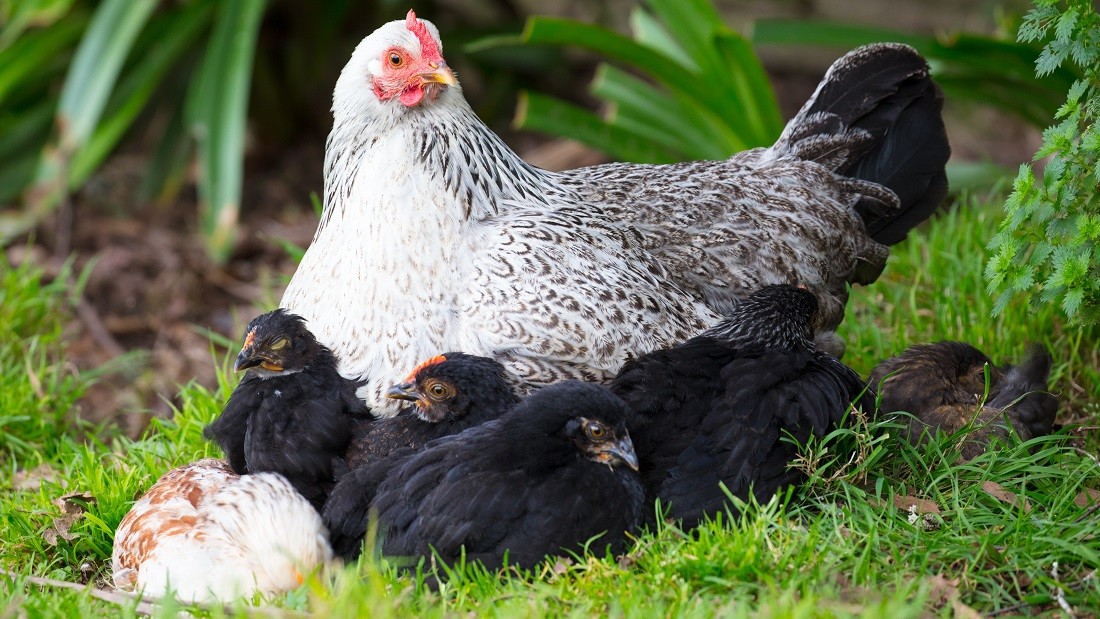
The life of a ‘meat chicken’ is short and brutal – from birth to death in just six to seven weeks. Selectively bred to gain weight quickly, most don’t see the light of day until they’re packed into a lorry and sent to slaughter. Their bodies are huge but their eyes still blue and their chirps, the mere cheeps of a chick.
The average 42-day lifespan of a ‘meat chicken’, commonly known as a broiler, is spent inside a foul-smelling industrial-sized shed with tens of thousands of other birds. As these young animals pile on the weight, their underdeveloped bones are unable to support them and many end up crippled or lame.
They often collapse onto the ammonia-rich faeces that cover the shed floor and develop painful burns on their feet and hocks – the scars of which are still evident on many carcasses lining supermarket shelves.1Perkins C. 2015. Aldi chicken with hock burn sparks Twitter storm. The Grocer. Available at: https://www.thegrocer.co.uk/food-safety/aldi-chicken-with-hock-burn-sparks-twitter-storm/518182.article [Accessed 30 November 2023]. Some broilers are unable to reach food and water points and die from starvation or dehydration, while others die from heart attacks or lung problems brought on by their rapid growth.
Factory farming will likely continue as long as most people are unconcerned about where their food comes from and unaware of chickens’ remarkable nature.

How many meat chickens are there in the UK?
With around 126 million alive at any one time, chickens reared for meat in the UK outnumber all other land-based farmed animals combined by almost three to one. Poultry farming is by far the largest food sector in the UK, with over one billion broilers killed every year.2Department for Environment, Food and Rural Affairs (Defra). 2023. Agriculture in the United Kingdom 2022. Defra. Available at https://www.gov.uk/government/statistics/agriculture-in-the-united-kingdom-2022 [Accessed 6 December 2023].Over time, this number has steadily risen due to the popularity of chicken meat, which has been promoted as healthier and more environmentally friendly than red meat.3Salazar E, Billing S and Breen M. Eating Better Alliance. 2020. We Need to Talk About Chicken. Eating Better Report February. Available at https://www.eating-better.org/uploads/Documents/2020/EB_WeNeedToTalkAboutChicken_Feb20_A4_Final.pdf [Accessed 6 December 2023].
In 2017, poultry overtook red meat sales for the first time according to a report from the Eating Better Alliance and now accounts for more than half of UK meat consumption.3Salazar E, Billing S and Breen M. Eating Better Alliance. 2020. We Need to Talk About Chicken. Eating Better Report February. Available at https://www.eating-better.org/uploads/Documents/2020/EB_WeNeedToTalkAboutChicken_Feb20_A4_Final.pdf [Accessed 6 December 2023].On average, people in the UK eat 33 kilograms of poultry per year.4Our World in Data. 2023. Per capita meat consumption by type, United Kingdom, 1961 to 2020. Available at https://ourworldindata.org/grapher/per-capita-meat-consumption-by-type-kilograms-per-year?country=~GBR [Accessed 6 December 2023].
More than 95 per cent of broiler chickens are intensively reared in factory farms5Soil Association. 2022. Peak poultry – briefing for policymakers. Available at https://www.soilassociation.org/media/22930/peak-poultry-briefing-for-policy-makers.pdf [Accessed 6 December 2023].22confined in large, closed buildings where temperature, artificial lighting, ventilation, food and water are controlled to ensure the birds grow efficiently. The majority of broilers are reared to standards the RSPCA believes “are not good enough in terms of animal welfare”6RSPCA. 2022. Welfare of meat chicken. Available at https://www.rspca.org.uk/documents/1494939/7712578/FAD-Meat-Chickens-Information-Sheet-2022.pdf [Accessed 6 December 2023]. – yet as Viva!’s investigations reveal time and time again little is being done to improve things. Free range production systems account for less than four per cent of the total market and organic, just one per cent.6RSPCA. 2022. Welfare of meat chicken. Available at https://www.rspca.org.uk/documents/1494939/7712578/FAD-Meat-Chickens-Information-Sheet-2022.pdf [Accessed 6 December 2023].
What is the UK meat chicken industry worth?
In 2022, the Department for Environment, Food and Rural Affairs (Defra) said the value of poultry meat production (including turkeys, ducks and geese) was £3.1 billion. The vast majority of that came from so-called ‘table chickens’.2Department for Environment, Food and Rural Affairs (Defra). 2023. Agriculture in the United Kingdom 2022. Defra. Available at https://www.gov.uk/government/statistics/agriculture-in-the-united-kingdom-2022 [Accessed 6 December 2023].
Poland, the UK, Spain, France and Italy are the top five producing countries; supplying 4.3 billion chickens in 2020 with three of the top ten European broiler producers based in the UK.7Compassion in World Farming. 2022. Chicken track 2022 European report. Available at https://www.ciwf.org.uk/media/7453677/european-chickentrack-2022.pdf [Accessed 6 December 2023].The 2 Sisters Food Group heads up the supply chain, closely followed by Moy Park and Avara Foods (a joint Faccenda Foods and Cargill venture). The 2 Sisters Food Group processes 10.4 million birds a week across Europe and employs more than 14,000 staff.82 Sisters Food Group. About Us. Available at: https://www.2sfg.com/about-us/ [Accessed 6 December 2023].Moy Park produced six million birds a week in 20189Moy Park. 2018. Moy Park achieves major production milestone. Available at https://moypark.com/news/moy-park-achieves-major-production-milestone [Accessed 6 December 2023].and Avara produces four and a half million birds a week.10Avara Foods. 2023. Homepage. Available at https://www.avarafoods.co.uk/ [Accessed 6 December 2023].
Chick production
Like chickens destined for the egg-laying industry, broilers begin life as an incubated egg. These eggs are the product of genetically selected ‘parent stock’ – a separate breeding flock used to produce viable eggs which are stored and hatched on tiered racks in vast numbers.
Under optimal conditions, with highly regulated temperatures and carbon dioxide concentrations, the chicks hatch after approximately 21 days. Hatcheries provide the perfect environment for bacteria to thrive.11Maharjan P, Cox S, Gadde U et al. 2017. Evaluation of chlorine dioxide based product as a hatchery sanitizer. Poultry Science. 96 (3) 560-565.On European poultry farms, formaldehyde is the primary sanitiser used in the routine sanitisation of hatching eggs but other substances, including chlorine dioxide-based products for example, are used to sanitise eggshell surfaces.12Oliveira GDS, McManus C, Salgado CB, Dos Santos VM. Effects of Sanitizers on Microbiological Control of Hatching Eggshells and Poultry Health during Embryogenesis and Early Stages after Hatching in the Last Decade. Animals (Basel). 2022 Oct 18;12(20):2826.
Naturally, mother hens would help their young break free of their shells but in the commercial industry, chicks have only their egg tooth to aid hatching. Once hatched, the chicks are vaccinated through misting or an injection on the back of the neck to protect them against diseases such as Marek’s disease, Newcastle disease virus and respiratory disease (infectious bronchitis).13European Food Safety Authority (EFSA). 2010. Scientific Opinion on welfare aspects of the management and housing of the grandparent and parent stocks raised and kept for breeding purposes. EFSA Journal. 8 (7) 1667. Available at https://efsa.onlinelibrary.wiley.com/doi/epdf/10.2903/j.efsa.2010.1667 [Accessed 6 December 2023].
Although some systems sex the birds, most don’t as both male and female chicks are used in broiler production.
Broiler breeders
Birds used to breed broiler chicks are called broiler breeders or parent stock. In the UK there are around eight million broiler breeders bred by the industry each year and each of these produce up to 140 chicks in their artificially short lifetime.
Broiler breeders may look very similar to broilers bred for meat during the first few weeks of age but have a considerably higher commercial value.14Department for Environment, Food and Rural Affairs (Defra). 2016. Broiler breeder rearing. Available at https://assets.publishing.service.gov.uk/government/uploads/system/uploads/attachment_data/file/580234/07-broiler-breeder-rearing-1612.pdf [Accessed 12 December 2023].For this reason, they are treated differently and usually reared in deep litter sheds with carefully managed lighting, temperature and ventilation. Broiler breeders are sub-divided into pens containing around 1,000 birds each. Stocking densities are not as high as those in regular broiler sheds, at approximately 25 kilograms of birds per square metre.15Farm Animal Welfare Council (FAWC), 1998. Report on the welfare of broiler breeders. FAWC. Available at https://assets.publishing.service.gov.uk/government/uploads/system/uploads/attachment_data/file/325543/FAWC_report_on_the_welfare_of_broiler_breeders.pdf [Accessed 12 December 2023].
Broilers have been bred to gain weight fast but for breeders, food is restricted (leading to prolonged hunger), to restrict growth and achieve desired levels of fertility.16EFSA AHAW Panel (EFSA Panel on Animal Health and Animal Welfare). 2023. Scientific Opinion on the welfare of broilers on farm. EFSA Journal. 21 (2) 7788, 236.Unlike their offspring, who reach adult weights at around six weeks old, parent stock grow much more slowly, reaching sexual maturity between 16 and 21 weeks old.
Hunger causes the birds psychological stress, resulting in an increased incidence of abnormal behaviours such as feather pecking and greater levels of aggression around feeding time.17Mench JA. 2002. Broiler breeders: feed restriction and welfare. World’s Poultry Science Journal. 58 (1) 23-29.They often drink more as well, which leads to wetter, poorer quality litter and subsequent skin (dermatitis) lesions or ammonia burns.15Farm Animal Welfare Council (FAWC), 1998. Report on the welfare of broiler breeders. FAWC. Available at https://assets.publishing.service.gov.uk/government/uploads/system/uploads/attachment_data/file/325543/FAWC_report_on_the_welfare_of_broiler_breeders.pdf [Accessed 12 December 2023].
Around 50 per cent of the breeding flock are male, in order to achieve the maximum number of fertile hatching eggs.15Farm Animal Welfare Council (FAWC), 1998. Report on the welfare of broiler breeders. FAWC. Available at https://assets.publishing.service.gov.uk/government/uploads/system/uploads/attachment_data/file/325543/FAWC_report_on_the_welfare_of_broiler_breeders.pdf [Accessed 12 December 2023]. Males are typically kept apart from females until at least six weeks of age and suffer from painful mutilations such as dubbing, despurring and declawing (see injury and mutilation section), in an effort to minimise some of the abnormal behaviours and consequences of living in highly unnatural and artificial environments.
Life-cycle
Unlike laying hens, which are nearly all brown, broilers typically have white feathers. Bred for rapid growth, 42-day-old broilers weigh four to five times as much as layer hens and their breast muscles may grow an astonishing eight times faster.18Buzala M and Janicki B. 2016. Effects of different growth rates in broiler breeder and layer hens on some productive traits. Poultry Science. 95 (9) 2151-2159.
As a result, modern broilers can reach an average UK slaughter weight of 2.2 kilograms in just 35 days.19RSPCA. 2020. Eat, sit, suffer, repeat. The life of a typical meat chicken. Available at https://www.rspca.org.uk/webContent/staticImages/BroilerCampaign/EatSitSufferRepeat.pdf [Accessed 12 December 2023].The most-commonly bred chicken for meat worldwide is the Ross breed. Other fast-growing breeds include the Arbor Acre, Cobb and Marshall.

Housing
Chicken farms are classed as ‘intensive’ if they have the capacity to house 40,000 or more poultry birds and as such require a permit from the Environment Agency to operate. From 2011 to 2015, the poultry sector saw a 27 per cent leap in the number of farms housing more than 40,000 birds.20Wasley A. 2018. Chicken mega-farms are how we’ll feed the UK, says poultry industry head. The Guardian. Available at https://www.theguardian.com/environment/2018/jul/03/intensive-chicken-mega-farms-feed-uk-poultry-industry-head-richard-griffiths [Accessed 12 December 2023].
In 2017, the number of large intensive farms – pig and poultry – with an Environment Agency permit in the UK stood at 1,674 – an increase of 26 per cent since 2011 when there were 1,332 facilities requiring a permit – and poultry farms accounted for 86 per cent of the total.20Wasley A. 2018. Chicken mega-farms are how we’ll feed the UK, says poultry industry head. The Guardian. Available at https://www.theguardian.com/environment/2018/jul/03/intensive-chicken-mega-farms-feed-uk-poultry-industry-head-richard-griffiths [Accessed 12 December 2023].
Over 95 per cent of chickens raised for meat in the UK are housed in giant intensive sheds with carefully monitored environments to encourage growth.5Soil Association. 2022. Peak poultry – briefing for policymakers. Available at https://www.soilassociation.org/media/22930/peak-poultry-briefing-for-policy-makers.pdf [Accessed 6 December 2023].For the first week of their lives, broiler chicks are subjected to constant lighting and require temperatures of 33°C.21Riley J. 2019. Is now the right time to go into poultry farming? Farmers Weekly. Available at https://www.fwi.co.uk/livestock/poultry/is-now-the-right-time-to-go-into-poultry-farming [Accessed 12 December 2023].After that, sheds are supposed to provide a period of four continuous hours of darkness, according to UK welfare recommendations.22Department for Environment, Food and Rural Affairs (Defra). 2019. Broiler (meat) chickens: welfare recommendations. Available at https://www.gov.uk/government/publications/poultry-on-farm-welfare/broiler-meat-chickens-welfare-recommendations [Accessed 12 December 2023].
In the UK, broiler sheds are not required by law to have windows and can rely on artificial lighting to stimulate activity. From October 2023, Red Tractor made windows a requirement, stipulating windows equate to a minimum of three per cent of the floor area in all buildings which house birds.23Red Tractor. 2023. Chickens – housing, shelter and handling facilities. Available at https://redtractorassurance.org.uk/standards/housing-shelter-and-handling-facilities/ [Accessed 12 December 2023].
Automated feed lines with circular pan or track feeders line the sheds and are carefully managed and designed to fatten the birds quickly. Water access is limited to nipple drinkers or less common bell drinkers and may be treated with peroxide or chlorine to try and limit bacterial growth. These treatments are generally removed five to seven days before slaughter in an effort to prevent them from entering the food chain.
According to Defra’s Code of Practice for the welfare of meat chickens and meat breeding chickens (2018), the distance any bird should have to travel in a house to reach feed should not be more than four metres and no more than three metres for water. Although water should be provided up to the start of the catching procedure for transportation to slaughter, food can be withheld for up to 12 hours.24Department for Environment, Food and Rural Affairs (Defra). 2018. Code of practice for the welfare of meat chickens and meat breeding chickens. Available at https://assets.publishing.service.gov.uk/government/uploads/system/uploads/attachment_data/file/694013/meat-chicken-code-march2018.pdf [Accessed 12 December 2023].
Litter, composed of straw, wood shavings, peat or paper, is laid to absorb broiler waste and is not usually cleaned or changed during their entire lifetime. With tens of thousands of birds sharing the same space, the litter can become wet very quickly. By sitting in their own waste, broilers are prone to suffer from contact dermatitis (ulcerated lesions), where the skin is chemically burned and eventually turns black (ammonia burns).25Colley C and Wasley A. 2020. Industrial-sized pig and chicken farming continuing to rise in UK. The Guardian. Available at https://www.theguardian.com/environment/2020/apr/07/industrial-sized-pig-and-chicken-farming-continuing-to-rise-in-uk#maincontent [Accessed 12 December 2023].
Researchers at the University of Cambridge found that these burns could be identified in 82 per cent of chickens sold in supermarkets but said the figure could be even higher as the lesions are often removed before meat goes on sale.26Broom DM and Reefmann N. 2005. Chicken welfare as indicated by lesions on carcases in supermarkets. British Poultry Science. 46 (4) 407‐414. Although more recent figures on burn incidences are difficult to find, a 2016 investigation suggests that one in three supermarket chickens still suffer from skin burns27Sommerlad N. 2016. Supermarket chickens are being kept in their own excrement, shock investigation claims. Mirror Online. Available at https://www.mirror.co.uk/news/uk-news/supermarket-chickens-being-kept-excrement-8871496 [Accessed 12 December 2023].and in 2020, The Guardian reported that one in 10 KFC chickens also suffer burns caused by ammonia.28Levitt T. 2020. KFC admits a third of its chickens suffer painful inflammation. The Guardian. Available at https://www.theguardian.com/environment/2020/jul/30/kfc-admits-a-third-of-its-chickens-suffer-painful-inflammation [Accessed 12 December 2023].
Additional straw bales to lay as top litter during may be stored inside the sheds and are counted as a form of enrichment. Other types of environmental enrichment include perches, low barriers and pecking objects such as traffic cones, empty containers and brassicas. There are no legal requirements as to how many pecking objects should be provided but initiatives like the Better Chicken Commitment call for at least two metres of usable perch space and two pecking substrates per 1,000 birds.29Better Chicken Commitment. 2023. The policy. Available at https://betterchickencommitment.com/eu/policy/ [Accessed 12 December 2023].
In some cases, flocks are ‘thinned’ as they get closer to their final slaughter weights in order to create more space for the remaining birds. According to the British Poultry Council, usually 25-30 per cent of birds (often female) are removed from the shed to be killed for markets that desire smaller birds, and the remainder are left to grow on.30British Poultry Council. 2020. Thinning. Available at https://www.britishpoultry.org.uk/glossary/thinning/ [Accessed 12 December 2023].Biosecurity measures are often broken during thinning and it increases stress levels in the units, which often leads to higher levels of disease outbreak.30British Poultry Council. 2020. Thinning. Available at https://www.britishpoultry.org.uk/glossary/thinning/ [Accessed 12 December 2023].
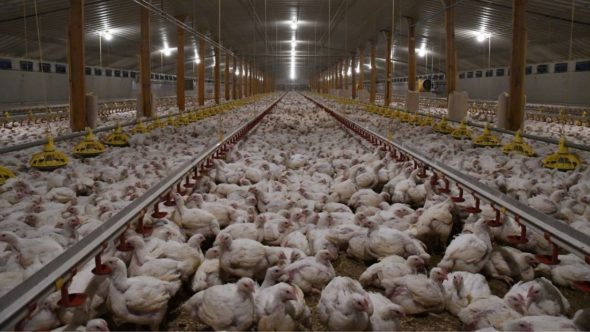
Up to 35,000 broiler chickens crammed into one shed
Free-range and organic
Both free range and organic production systems adhere to conditions outlined by EU regulations (543/2008 for free range and 889/2008 for organic).31European Union. 2007. Laying down minimum rules for the protection of chickens kept for meat production. Official Journal of the European Union. Available at https://eur-lex.europa.eu/legal-content/EN/TXT/PDF/?uri=CELEX:32007L0043&from=EN [Accessed 12 December 2023].
Extensive indoor, free range and traditional free range are all marketing terms for slower growing breeds of birds, such as the JA757, reared for around 56 days (as opposed to the standard 42) with fewer birds permitted per square metre of indoor space. They also have daytime access to open-air runs for a fixed period during their lives.
Organic broilers may have it a little easier than free range birds with daily access to the outdoors for at least a third of their lives and are reared to a lower stocking density over a longer period of time. However, both free range and organic birds spend most of their lives indoors and they are killed from just two months old.
Injury and mutilation
Lameness is a common occurrence on broiler farms as a result of selective breeding. The birds’ rapid weight gain leads to developmental abnormalities in their bones and joints, which are exacerbated by stress and infections caused by bacteria such as Enterococcus caecorum and Staphylococcis aureus.
Almost one-third of intensively reared broiler chickens in the UK develop heart and lung problems and more than half of the birds in flocks with fast-growing breeds have severe walking problems.25Colley C and Wasley A. 2020. Industrial-sized pig and chicken farming continuing to rise in UK. The Guardian. Available at https://www.theguardian.com/environment/2020/apr/07/industrial-sized-pig-and-chicken-farming-continuing-to-rise-in-uk#maincontent [Accessed 12 December 2023]. These leg disorders likely cause chronic pain and have been identified by the European Commission’s Scientific Committee on Animal Health and Animal Welfare (SCAHAW) as “a major cause of poor welfare in broilers”.32Science Committee on Animal Health and Animal Welfare (SCAHAW). 2000. The welfare of chickens kept for meat production (broilers). Available at https://food.ec.europa.eu/system/files/2020-12/sci-com_scah_out39_en.pdf [Accessed 12 December 2023].
Other injuries broilers suffer are a result of feather pecking and cannibalism. These behavioural issues often develop when the chicks are just a few weeks old and can become a habit that spreads through the flock. Once stressed, young broilers begin picking the feathers, combs, toes or vents of other birds.
Once a wound has opened, the blood may drive cannibalistic behaviour. Yet despite knowing that environmental enrichment significantly lessens instances of injurious feather pecking (IFP), there are no legal requirements to provide it.
Unlike egg-layers, broilers in Britain are not typically beak-trimmed as they’re normally slaughtered before reaching sexual maturity.24Department for Environment, Food and Rural Affairs (Defra). 2018. Code of practice for the welfare of meat chickens and meat breeding chickens. Available at https://assets.publishing.service.gov.uk/government/uploads/system/uploads/attachment_data/file/694013/meat-chicken-code-march2018.pdf [Accessed 12 December 2023]In an effort to prevent aggression in breeding (parent stock) birds, who do reach sexual maturity, it’s generally only the males that have their beaks trimmed. The process is carried out at around five days of age and can lead to severe and lasting pain.
Damage to the beak is intensely painful, as partially debeaked chickens show a significant increase in guarding behaviour – tucking their bill under the wing – and diminished use of the bill for pecking and preening after the procedure. These pain-related behaviours may continue for months.33Marino L. 2017. Thinking chickens: a review of cognition, emotion, and behavior in the domestic chicken. Animal Cognition. 20 (2) 127-147.
The removal of all or part of the comb (dubbing), the removal of the spur bud on the back of the leg (despurring) and the removal of the dew and pivot claw from the feet (declawing) are all other mutilations that may be carried out on male broiler-breeders. Dubbing supposedly helps to limit sexing errors during rearing and helps avoid loses due to excessive comb growth, whereas despurring and declawing reduces damage to female birds during mating.15Farm Animal Welfare Council (FAWC), 1998. Report on the welfare of broiler breeders. FAWC. Available at https://assets.publishing.service.gov.uk/government/uploads/system/uploads/attachment_data/file/325543/FAWC_report_on_the_welfare_of_broiler_breeders.pdf [Accessed 12 December 2023].42Department for Environment, Food and Rural Affairs (Defra). 2019. Guidance Broiler (meat) chickens: welfare recommendations. Defra. Available at https://assets.publishing.service.gov.uk/government/uploads/system/uploads/attachment_data/file/732227/code-of-practice-welfare-of-laying-hens-pullets.pdf [Accessed 12 December 2023].
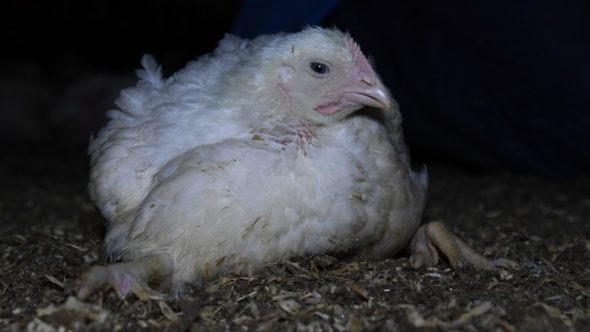
Suffering from joint degeneration, this broiler chicken is unable to stand
Diseases
Infectious diseases can run rampant on factory farms – which provide the perfect environment for rapid spread. An outbreak of Campylobacter, for instance, can infect most chickens in a shed of 30,000 within 72 hours to one week.35Ramabu S, Boxall N, Madie P et al. 2004. Some potential sources for transmission of Campylobacter jejuni to broiler chickens. Letters in Applied Microbiology. 39, 252-256.It is often spread from shed to shed during the thinning stage (where some birds are removed to prevent further overcrowding and for certain markets that favour smaller chickens for human consumption) due to poor biosecurity measures in place on the farm.
Campylobacter is a pathogenic (disease causing) bacterium that can infect humans and is the most common form of food poisoning in the UK. According to Defra, cases increased in 2017 after a decline over the previous two years and are associated with the consumption of chicken or duck liver parfait or paté.36Department for Environment, Food and Rural Affairs (Defra). 2018. Zoonoses Report UK 2017. Available at https://assets.publishing.service.gov.uk/government/uploads/system/uploads/attachment_data/file/765111/UK_Zoonoses_report_2017.pdf [Accessed 12 December 2023].
In the UK and abroad, E. coli and Salmonella enteritidis are other well-known food-borne bacteria that when ingested can lead to serious food poisoning. Symptoms include diarrhoea, vomiting, nausea, fever, and abdominal pain.
Bird flu is another classic example of a zoonotic disease, caused by an avian influenza virus, it has been infecting wild birds and domesticated poultry since the 1950s but in 1996 a highly pathogenic strain of H5N1 killed more than 40 per cent of the birds it infected. The virus has become more deadly directly due to factory farming – the intensely overcrowded conditions enable the virus to mutate and spread. Commercial poultry farms, wet markets, poultry slaughtering facilities, pig farms, human dietary habits and the global trade in exotic animals are all implicated in the spread of influenza viruses.
There are lots of different strains of bird flu virus. Most of them don’t infect humans. But four strains have caused concern in recent years: H5N1 (since 1997), H7N9 (since 2013), H5N6 (since 2014) and H5N8 (since 2016).37NHS, 2022. Bird flu. Available at https://www.nhs.uk/conditions/bird-flu/ [Accessed 12 December 2023].H5N1 is a virus concerning many scientists as the mortality rate in humans is a terrifying 52 per cent.38WHO. 2023. Human infection with avian influenza A(H5) viruses. Available at https://cdn.who.int/media/docs/default-source/wpro—documents/emergency/surveillance/avian-influenza/ai_20231203.pdf [Accessed 12 December 2023].By contrast, seasonal flu kills about 0.1 per cent of those infected. Globally, more than 15,000 outbreaks of infection with H5N1 were reported in domestic birds such as chickens, ducks, turkeys and geese between 2005 and 2018.39Chowdhury S, Hossain ME, Ghosh PK et al. 2019. The pattern of highly pathogenic avian influenza H5N1 outbreaks in South Asia. Tropical Medical and Infectious Diseases. 4 (4) 138.Most cases of infection in humans have involved individuals handling, slaughtering or consuming infected poultry and as of December 2006, more than 240 million poultry either died or were slaughtered to prevent the spread of this virus.39Chowdhury S, Hossain ME, Ghosh PK et al. 2019. The pattern of highly pathogenic avian influenza H5N1 outbreaks in South Asia. Tropical Medical and Infectious Diseases. 4 (4) 138.
As of the end of 2023, over 880 people have been infected with the H5N1 avian influenza viruses and over 460 have died, with fatalities in Azerbaijan, Bangladesh, Cambodia, Canada, China, Egypt, India, Indonesia, Iraq, Lao People’s Democratic Republic, Nepal, Nigeria, Pakistan, Thailand, Turkey and Viet Nam.38WHO. 2023. Human infection with avian influenza A(H5) viruses. Available at https://cdn.who.int/media/docs/default-source/wpro—documents/emergency/surveillance/avian-influenza/ai_20231203.pdf [Accessed 12 December 2023].These numbers might seem low, compared with other pandemics, however, if the virus changes to become more easily spread between humans, we could be facing a pandemic far deadlier than Covid-19.
Assurance schemes
TThere are a number of assurance schemes for broilers, including Red Tractor, The Soil Association and RSPCA Assured. The UK standard allows for 39 kilograms (between 19 to 20 birds at adult weight of two kilograms) per square metre, whereas Red Tractor and RSPCA Assured allows for 38 kilograms (19 birds at adult weight) per square metre and 30 kilograms (15 birds at adult weight) per square metre respectively.
Red Tractor say that over 95 per cent of chicken farms in the UK are Red Tractor assured, as many retailers insist upon this as a minimum. When buying chicken, consumers seem more reluctant to pay for higher welfare chickens and RSPCA Assured birds account for just 1.2 per cent of the market.40RSPCA. 2023. Better chicken. Available from https://www.rspca.org.uk/getinvolved/campaign/betterchicken [Accessed 12 December 2023].Sales of RSPCA Assured (previously Freedom Foods) chicken have not seen year-on-year growth.21Riley J. 2019. Is now the right time to go into poultry farming? Farmers Weekly. Available at https://www.fwi.co.uk/livestock/poultry/is-now-the-right-time-to-go-into-poultry-farming [Accessed 12 December 2023].
Better Chicken Commitment
Since November 2016, the Better Chicken Commitment has been growing in momentum across the world. Over 170 leading food companies have publicly committed to improving welfare practices for chickens that stipulate a change in breed type, stocking densities and lighting levels, among other standards.
An initiative involving a coalition of European animal welfare groups, including the RSPCA and Compassion in World Farming, the commitment promotes phasing out breeds such as the Ross 308 for slower-growing Ranger golds in order to improve the lives and health of chickens bred for meat.
Although the improvements outlined by the Better Chicken Commitment have not been incorporated into law, the coalition is calling for retailers and food outlets to pledge to source chicken only from producers applying the higher welfare standards by 2026.30 Its biggest roadblock in achieving that goal is the 33p per bird cost increase in rearing costs and the 22 per cent extra land required to produce a tonne of Better Chicken Commitment poultry meat compared with intensively farmed, fast-growing birds.41Davie J. 2020. What the Better Chicken Commitment means for farmers. Farmers Weekly. 8 February. Available at https://www.fwi.co.uk/livestock/poultry/broilers/what-the-better-chicken-commitment-means-for-farmers [Accessed 17 July 2020].
However, the conditions proposed by the Better Chicken Commitment are still grossly unnatural, and chickens all end up at the slaughterhouse at a mere fraction of their natural lives.
In the UK, we now kill more than one billion broiler chickens annually, that’s nearly three million birds a day.1Department for Environment, Food and Rural Affairs (Defra), 2023. Agriculture in the United Kingdom 2022. Defra. Available at https://www.gov.uk/government/statistics/agriculture-in-the-united-kingdom-2022 [Accessed 12 December 2023].As with poultry farming, slaughter is big business and as with any business, time is money – which means the slaughter lines prioritise speed over welfare. Broiler chickens are killed at just six to seven weeks old; a chicken’s natural lifespan is five to eight years and some live 10 to 12 years.
Catching and depopulation
To maintain a high profit margin, it is common practice in poultry farming to overstock sheds. This not only allows for a high mortality rate but also provides for the thinning of flocks for markets that, for one reason or another, prefer smaller birds.
In 2020, the British Poultry Council claimed that the average mortality rate for the industry as a whole was two to three per cent (23 to 34 million birds a year).2Levitt T. 2020. KFC admits a third of its chickens suffer painful inflammation. The Guardian. Available at https://www.theguardian.com/environment/2020/jul/30/kfc-admits-a-third-of-its-chickens-suffer-painful-inflammation [Accessed 12 December 2023].However, an analysis of official figures in a 2023 report by the animal welfare campaign group Open Cages found 82.3 million chickens died before reaching kill weight last year, a mortality rate of nearly seven per cent.3Ungoed-Thomas J. 2023. Premature death of 80m chickens raises concerns over UK’s fast-growing breeds. The Observer. Available at https://www.theguardian.com/world/2023/nov/11/premature-death-of-80m-chickens-raises-concerns-over-uks-fast-growing-breeds [Accessed 13 December 2023].The UK’s Red Tractor farm assurance scheme requires mortality rates not to exceed five per cent.4Red Tractor. 2023. Animal health and welfare. Available at https://redtractorassurance.org.uk/standards/animal-health-and-welfare-5/ Accessed 13 December 2023].
In a practice called ‘thinning’, up to six thousand birds may be removed from a shed, allowing those that remain more room to grow. It involves rearing the birds to the maximum permitted stocking density before removing a proportion of them, often by hand at around four to five weeks of age. As it’s linked to higher Campylobacter rates by the European Food Safety Authority (EFSA), the RSPCA Assured scheme banned it in 2016.5Perkins C. 2015. RSPCA bans chicken flock thinning to improve welfare and cut campylobacter. The Grocer. 23 November. Available at https://www.thegrocer.co.uk/meat/rspca-bans-chicken-flock-thinning-to-improve-welfare/528057.article [Accessed 17 August 2020].But as stated, only 1.2 per cent of chicken in the UK is produced under the RSPCA Assured label.6RSPCA. 2023. Better chicken. Available from https://www.rspca.org.uk/getinvolved/campaign/betterchicken [Accessed 12 December 2023].
Thinning remains common practice in intensive poultry systems because it allows farmers to maximise space for rearing birds while meeting necessary requirements for stocking densities and market demand for different sizes of birds.
When thinning and depopulating the shed, lighting is kept low to minimise panic amongst the birds. Workers catch birds by their legs and cram them into crates, while forklifts drive back and forth carrying full crates to transport trucks.
According to government guidelines, no catcher should carry by the legs more than three chickens (or two adult breeding birds) in each hand and birds must not be carried by the wings or by the neck.7Department for Environment, Food and Rural Affairs (Defra). 2018. Code of practice for the welfare of meat chickens and meat breeding chickens. Available at https://assets.publishing.service.gov.uk/media/5ab525afed915d78b9a45b0f/meat-chicken-code-march2018.pdf [Accessed 12 December 2023].
Government guidelines also indicate that birds should not be deprived of feed or water before transport, but feed and watering lines are often raised to allow catchers and forklift drivers better access to the sheds. Prior to slaughter, feed can be withheld for up to 12 hours, but not water.7Department for Environment, Food and Rural Affairs (Defra). 2018. Code of practice for the welfare of meat chickens and meat breeding chickens. Available at https://assets.publishing.service.gov.uk/media/5ab525afed915d78b9a45b0f/meat-chicken-code-march2018.pdf [Accessed 12 December 2023].
Transport
Once the birds are loaded into crates to be transported to the slaughterhouse, the Government’s guidelines are extremely vague, stating only for the welfare of laying hens and pullets that: “During the time birds are held in the containers prior to and after transport they should be protected from bad weather and excessively hot or cold conditions.”8Department for Environment, Food and Rural Affairs (Defra). 2018. Code of practice for the welfare of laying hens and pullets. Available at https://assets.publishing.service.gov.uk/media/5b69652be5274a1518c298db/code-of-practice-welfare-of-laying-hens-pullets.pdf [Accessed 12 December 2023].
During the time birds are held in the containers prior to and after transport they should be protected from bad weather and excessively hot or cold conditions. As the sides of transport trucks are usually open, birds are often subjected to weather extremes in both summer and winter months, with no additional provisions in place.
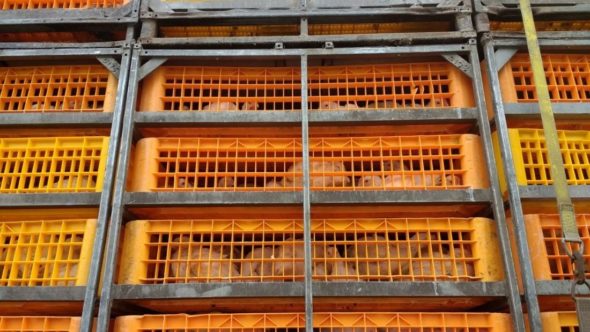
Broilers in a transport truck on route to slaughter
There are also no definitive time limits on transportation in the Welfare of Animals (Slaughter or Killing) Regulations, it merely suggests that animals should be unloaded as soon as possible after arrival at a slaughterhouse.9Gov.uk. 2023. White meat slaughterhouses: unloading, handling, holding, restraining, stunning and killing. Available at h https://www.gov.uk/guidance/white-meat-slaughterhouses-unloading-handling-and-holding-restraining-stunning-killing [Accessed 13 December 2023].
It is more likely that producers’ interpretations of the legislation will be informed more by commercial priority than animal welfare.
Slaughter
Chickens killed for meat are slaughtered in two ways – either by controlled atmosphere systems (gassing) or electrical stunning and throat cutting. Gas systems are the main slaughter method for chickens. In 2022, the Food Standards Agency reported in their slaughter methods survey that gas killing accounted for 80 per cent of poultry slaughters.10Department for Environment, Food and Rural Affairs (Defra), 2022. Results of the 2022 FSA Survey into Slaughter Methods in England and Wales. Available at https://assets.publishing.service.gov.uk/media/62f0eec1d3bf7f75b305fbae/Results-of-the-2022-FSA-Slaughter-Sector-Survey-in-England-and-Wales.pdf [Accessed 12 December 2023].
To gas kill chickens, birds remain in the crates in which they were transported and are placed into a chamber. They are then exposed to mixtures of air and gas until dead. It’s generally considered to have welfare advantages over electrical stunning and throat cutting because it bypasses the live shackling stage. Gas killing birds is not a method that can be used for religious slaughter, as animals must be alive when their throats are cut.
Inhalation of carbon dioxide can cause distress, which leads the birds to gasp and shake their heads, so it may only be used under special license from Defra. Argon gas is undetectable to chickens and is believed to be less stressful for the birds but it is the most expensive of the gases and can lead to skin haemorrhaging.
Electrical stunning and throat cutting involves hanging live birds upside down by their legs on metal shackles and moving them along a conveyor belt towards an electrified water bath. When the bird’s head touches the water, an electrical circuit between the water bath and shackle stuns the birds before they move along the line to a mechanical neck cutter that severs the major blood vessels in their necks.
The high throughput in slaughterhouses – which have line speeds up to 15,000 birds an hour – leads to considerable welfare concerns. Some birds, who lift their heads away from the water baths, miss being stunned entirely and have their throats cut while still fully conscious. The neck cutter is also fallible, as some birds have been found to receive only single cuts while others are missed entirely. In these instances, birds may be fully or partially conscious when they enter the scalding tanks to loosen their feathers and are essentially boiled alive.
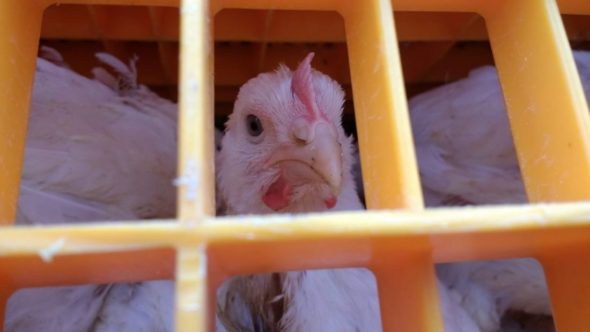
A crated broiler chicken pre-slaughter
Conclusion
The explosion of broiler production worldwide is a disaster for both chickens and consumers. Growing levels of obesity, dwindling feed stocks, food poisoning and the ever-looming threat of a global pandemic – as well as the staggering scale of appalling suffering involved in poultry farming – makes it crystal clear that the solution to all these problems is to choose vegan.

